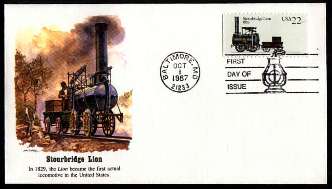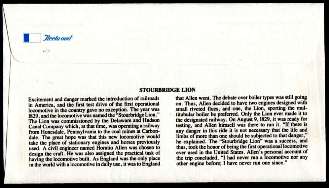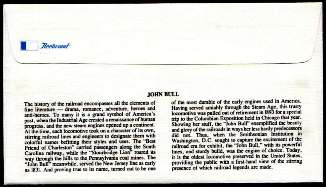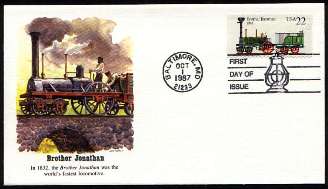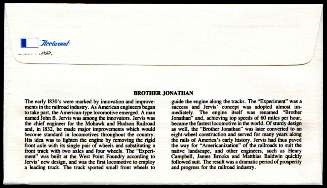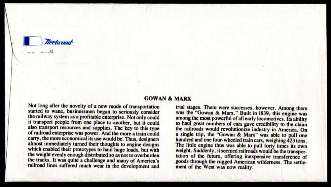22¢ LOCOMOTIVES BOOKLET ISSUE - October 1, 1987
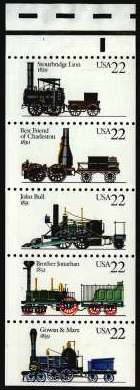 Sc. 2362-66
Sc. 2362-66
issued 10/1/87
|
 Sc. 2362-66
Sc. 2362-66
booklet cover
|
Below is the very attractive first
day ceremony program for this issue, with an enlargement of the artwork for the
Brother Jonathan stamp. You probably can't see it on the scan, but the front cover is
die-cut at the bottom - the wheels are part of the cover, while the tracks are part of
the inside. See the cancel inside peeking out under the belly of the locomotive?
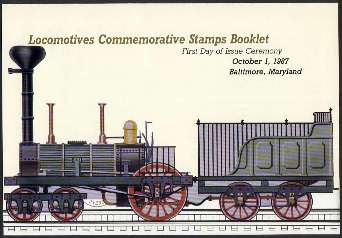
Scott 2362-66 First Day Ceremony Program - USPS
Here is the text from the inside of the program:
|
Steam locomotives chugging across the plains of America pulled
railroad cars filled with raw materials, adventuresome settlers and U.S. Mail from the
more densely populated eastern seaboard to the sparsely occupied west.
Along the way, early railroad transportation had probably the single greatest influence
on the development of American progress during the 1800s. It opened the frontier for
settlement and helped change small towns into transportation hubs that would eventually
become America's largest cities.
Railroads helped bring the eastern and western coasts of America's vast continent closer
together. The Postal Service is pleased to pay tribute to the industrial pioneers of our
nation ? those who helped us forge our way into the future ? through their genius,
designing the locomotives: through their labor, constructing the railroad; and through
their courage, facing the unknown frontier. This colorful booklet of five stamps
featuring locomotives, designed by Richard Leech of Orinda, California, celebrates the
contributions made to our country's development by man and machine.
|
I find that an odd way to present these stamps, picturing five of the most important
early American locomotives, which predated all of the events mentioned. These are all
very early designs (1829-39), marking key advances in the initial development of rail
locomotive technology. The chronology below puts them in context:
|
KEY DATES IN THE HISTORY OF THE RAILROADS IN THE US
1804 - Oliver Evans, Philadelphia, builds first American locomotive.
1830 - First steam locomotive, The Best Friend of Charleston, put into service, South
Carolina Railroad.
1830 - First common-carrier railroad, the Baltimore & Ohio.
1831 - First mail carried on railroad, South Carolina.
1837 - First locomotive whistle.
1851 - First train reaches Lake Erie.
1852 - First train reaches Chicago from the East.
1858 - First Pullman sleeping car goes into operation.
1863 - First successful rail labor union, Brotherhood of the Footboard.
1869 - First transcontinental railway completed.
1869 - Westinghouse patents air brake.
1870 - First through train, coast to coast, Boston-San Francisco.
1875 - First parlor car by Pullman.
1883 - Standard time belts adopted.
1885 - Janney automatic coupler approved.
1893 - Federal law requires air brakes and automatic couplers.
1900 - Casey Jones goes to Promised Land.
1905 - Fastest run by American passenger train, Broadway Limited of the Pennsylvania,
127.
06 miles per hour.
1931 - First air-conditioned train, Baltimore & Ohio.
1934 - First streamlined Diesel train.
The text above is from an enclosure in a "Kribbs Cover" for this issue, by KEN AND ANGIE
KRIBBS
|
The Fleetwood FDCs below do a much better job of explaining the importance of the
locomotives pictured on these stamps.
And here is an interesting and amusing story and illustration about the earliest days
of US railroads:
|

A PLEASURE RIDE ON AN EARLY AMERICAN TRAIN
A train on the Mohawk and Hudson Railroad, July 31, 1831, between Albany and
Schenectady, New York, carried politicians from the state capital on a tour of
inspection. 'In spite of its clumsy appearance the engine was able to haul its load at a
rate of thirty miles an hour on the level stretches, though when it entered the hills it
had to be pulled up an inclined plane by a stationary engine. The cars were stage
coaches. When the engine started they were jerked so violently by the loose couplings
that "Whigs and Democrats embraced each other, or were thrown to the floor." Startled by
the strange spectacle of the puffing monster, horses and even people ran in terror. The
shower of pine sparks was so heavy that, on one occasion at least, a stop had to be made
at a water tank to allow passengers to extinguish their burning clothes and umbrellas.
The illlustration and text above are from an enclosure in a "Kribbs Cover" for this
issue, by KEN AND ANGIE KRIBBS. The illustration shows the De Witt Clinton - click here for a photo and additional text about
that engine.
|

|
|








